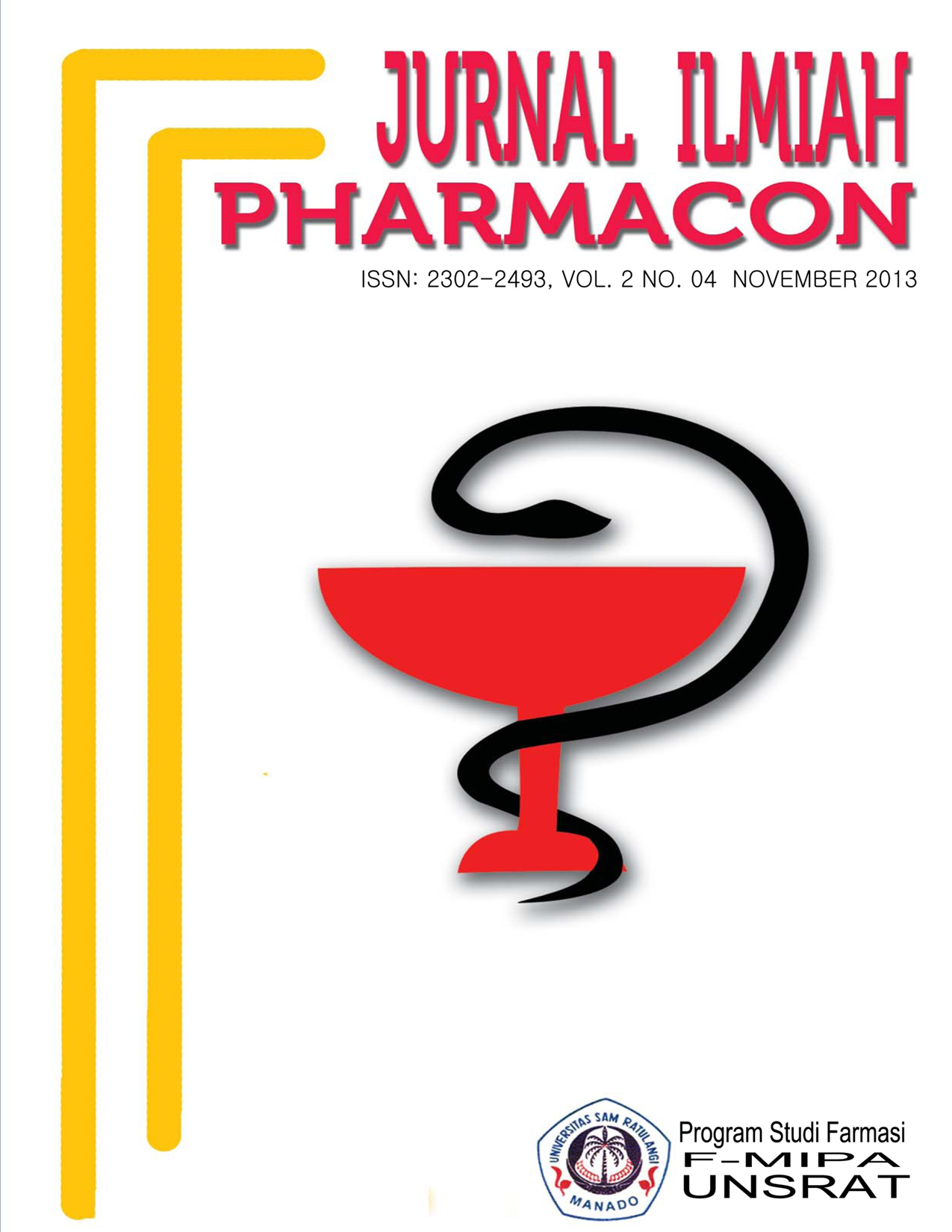AKTIVITAS ANTIFOTOOKSIDASI DAN PENGHAMBATAN PEMBENTUKKAN AGEs (ADVANCED GLYCATION END PRODUCTS) EKSTRAK KULIT BUAH PISANG GOROHO (Musa acuminate)
DOI:
https://doi.org/10.35799/pha.7.2018.21420Abstract
AKTIVITAS ANTIFOTOOKSIDASI DAN PENGHAMBATAN PEMBENTUKKAN AGEs (ADVANCED GLYCATION END PRODUCTS) EKSTRAK KULIT BUAH PISANG GOROHO (Musa acuminate)
Jane Beatrix Rety Kowaas1), Edi Suryanto2), Defny Silvia Wewengkang3)
1)Program studi Farmasi FMIPA Unsrat Manado, 95115
2)Jurusan Kimia FMIPA Unsrat Manado, 95115
ABSTRACT
This study aims to determine the activity of antiphotooxidation and inhibition of the formation of AGEs (Advanced Glycation End Products) of Goroho Banana Fruit Bark Extract (Musa acuminate). The research was started by extracting goroho banana peel using infusion method for 15 minutes with 50% ethanol, 100% ethanol, and distilled water at 90 oC. Then determined the total phenolic content, free radical antidote activity, photooxidation potential against linoleic acid, and determination of inhibition of the formation of AGEs (Advanced Glycation End Products) in vitro. The results showed that 100% ethanol extract had the highest total phenolic content with a value of 114.49 µg / g, followed by distilled water extract with a value of 62.04 µg / g, and 50% ethanol extract with a value of 40.91 µg / g. The 100% ethanol extract also has the highest total content of free radical antidote compared to other extracts. In antiphotooxidation testing of linoleic acid, 100% ethanol extract also showed the greatest activity in counteracting lipid oxidation and has an inhibition of the formation of AGEs (Advanced Glycation End Products) more effectively than other extracts. Based on this study, it can be concluded that 100% ethanol extract can act as antipotooxidation and inhibitors of AGEs (Advanced Glycation End Products) formation better than other extracts.
Keywords: Antiphotoxidation, AGEs (Advanced Glycation End Products), Fruit Skin Goroho Banana (Musa acuminate)
ABSTRAK
Penelitian ini bertujuan untuk menentukan aktivitas antifotooksidasi dan penghambatan pembentukan AGEs (Advanced Glycation End Products) Ekstrak Kulit Buah Pisang Goroho (Musa acuminate). Penelitian dimulai dengan mengekstraksi kulit buah pisang goroho menggunakan cara infusa selama 15 menit dengan pelarut etanol 50%, etanol 100%, dan aquades pada suhu 900C. Kemudian ditentukan kandungan total fenolik, aktivitas penangkal radikal bebas, potensi fotooksidasi terhadap asam linoleat, dan penentuan penghambatan pembentukan AGEs (Advanced Glycation End Products) secara in vitro. Hasilnya menunjukkan bahwa ekstrak etanol 100% memiliki kandungan total fenolik tertinggi dengan nilai 114,49 µg/g, diikuti ekstrak aquades dengan nilai 62,04 µg/g, dan ekstrak etanol 50% dengan nilai 40,91µg/g. Ekstrak etanol 100% juga memilki kandungan total aktivitas penangkal radikal bebas yang tertinggi dibandingkan dengan ekstrak lain. Pada pengujian antifotooksidasi terhadap asam linoleat, ekstrak etanol 100% juga menunjukkan aktivitas terbesar dalam menangkal oksidasi lipid dan memiliki penghambatan pembentukan AGEs (Advanced Glycation End Products) lebih efektif dibandingkan dengan ekstrak lainnya. Berdasarkan penelitian ini, dapat disimpulkan bahwa ekstrak etanol 100% dapat berperan sebagai antifotooksidasi dan penghambat pembentukan AGEs (Advanced Glycation End Products) lebih baik dibandingkan dengan ekstrak lainnya.
Kata kunci : Antifotoksidasi, Penghambat AGEs (Advanced Glycation End Products), Kulit BuahPisang Goroho (Musa acuminate)
Downloads
Published
How to Cite
Issue
Section
License
Authors who publish with this journal agree to the following terms:
- Authors retain copyright and grant the journal right of first publication with the work simultaneously licensed under a Creative Commons Attribution License that allows others to share the work with an acknowledgement of the work's authorship and initial publication in this journal.
- Authors are able to enter into separate, additional contractual arrangements for the non-exclusive distribution of the journal's published version of the work (e.g., post it to an institutional repository or publish it in a book), with an acknowledgement of its initial publication in this journal.
- Authors are permitted and encouraged to post their work online (e.g., in institutional repositories or on their website) prior to and during the submission process, as it can lead to productive exchanges, as well as earlier and greater citation of published work (See The Effect of Open Access)










